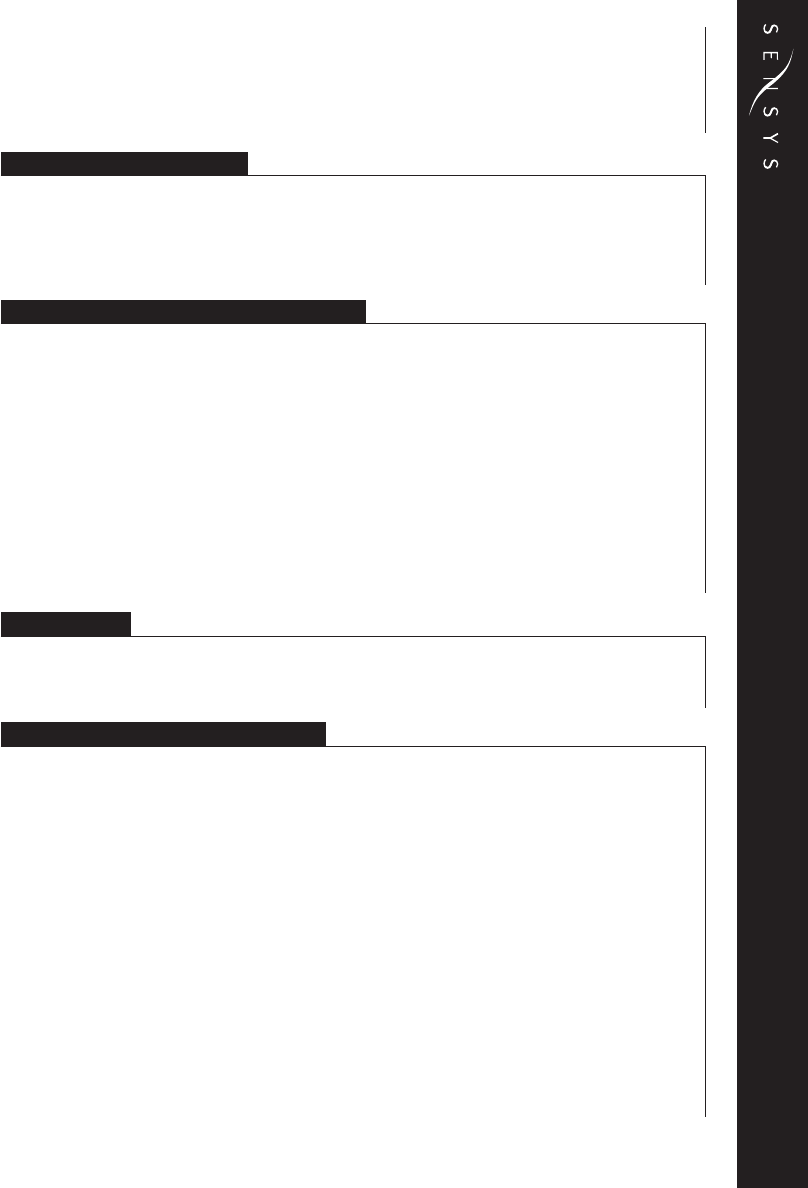
5
WARNING: ENSURE THAT THE SPIKES ARE LEVELLED AND THAT THE LOCK NUTS ARE
TIGHTENED FIRMLY. THE SPIKES SHOULD BE PUSHED THROUGH THE CARPET TO
LOCATE INTO THE FLOORING SURFACE BY APPLYING PRESSURE TO THE TOP OF THE
CABINET. IF USING ON A SENSITIVE FLOOR SURFACE PLACE THE PROTECTIVE CUPS
UNDER THE LEVELLED SPIKES. FAILURE TO DO SO COULD RENDER THE SPEAKER
UNSTEADY AND RESULT IN DAMAGE OR INJURY SHOULD IT BE KNOCKED OVER.
STAND MOUNTING MODELS
Stand mounting or bookshelf speakers should be located securely on stands or a shelf
in an appropriate position to place the
WideBand™
high frequency unit roughly at ear
height when seated in the chosen listening position. Positioning recommendations for
stand-mounted speakers can be found under the section entitled Positioning and
fine-tuning.
WALL MOUNTED REAR CHANNEL SPEAKERS
The Sensys R and Sensys DC1 have been designed to act as rear speakers in a multi
channel system configured for home cinema applications. Both models are provided with
threaded inserts in their rear panels to accommodate the fixing hardware for an Omni-
Mount type speaker wall bracket. This widely available design of bracket allows the speaker
to be angled to provide the best acoustic performance from the rear soundstage.
(See fig. 13)
WARNING: IT IS ESSENTIAL TO SELECT THE CORRECT TYPE OF SCREWS AND FIXINGS
TO SUIT THE CONSTRUCTION MATERIAL OF THE WALL ONTO WHICH THE SPEAKER
IS TO BE MOUNTED. ENSURE THAT THE OMNI-MOUNT HANGING BRACKET IS FIXED
TO THE WALL IN A SECURE MANNER; FAILURE TO DO SO COULD RESULT IN DAMAGE
OR INJURY SHOULD THE SPEAKER BECOME DETACHED IN USE. SEEK PROFESSIONAL
ADVICE IF YOU ARE UNSURE WHICH WALL FIXING IS BEST SUITED TO YOUR PROPOSED
MOUNTING LOCATION.
INSTALLATION
To avoid potential damage to your loudspeaker, ensure that the amplifier is switched OFF
prior to connecting or disconnecting any cables. Before switching on double check that
all connections are secure and that polarity is correct.
CONNECTION IN SINGLE WIRE MODE
The terminal panels in both Sensys Discrete and Dual Concentric™ models have captive
link bars fitted as standard to link the positive and negative HF and LF terminals respectively.
These must be removed to bi-wire the speakers - see section entitled Connection in Bi-
wire mode. (See figs. 3 & 7)
For optimum performance in single wire mode, loudspeaker cable connections from the
amplifier should be made to the high frequency (HF) terminals of the loudspeaker:
•The positive (plus) terminal on the amplifier left channel (marked + or coloured red)
must be connected to the positive HF terminal on the left speaker. The left speaker is the
one on the left as you look at the stereo pair from your listening position.
•The negative (minus) terminal on the amplifier left channel (marked - or coloured black)
must be connected to the negative HF terminal on the left speaker.
•Repeat this connection process for the right speaker. Remember that the positive (+ or
red) on the amplifier must be connected to the positive (+ or red) on the speaker and
the negative (- or black) to negative.
•Select a signal source, such as a CD player; switch on the amplifier and slowly turn up
the volume control to check that both loudspeakers are reproducing bass and treble
information.


















